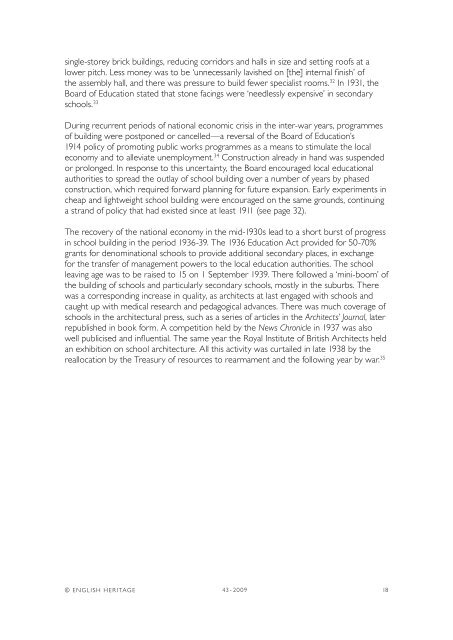innerâlondon schools 1918â44 a thematic study - English Heritage
innerâlondon schools 1918â44 a thematic study - English Heritage
innerâlondon schools 1918â44 a thematic study - English Heritage
- No tags were found...
You also want an ePaper? Increase the reach of your titles
YUMPU automatically turns print PDFs into web optimized ePapers that Google loves.
single-storey brick buildings, reducing corridors and halls in size and setting roofs at alower pitch. Less money was to be ‘unnecessarily lavished on [the] internal finish’ ofthe assembly hall, and there was pressure to build fewer specialist rooms. 32 In 1931, theBoard of Education stated that stone facings were ‘needlessly expensive’ in secondary<strong>schools</strong>. 33During recurrent periods of national economic crisis in the inter-war years, programmesof building were postponed or cancelled—a reversal of the Board of Education’s1914 policy of promoting public works programmes as a means to stimulate the localeconomy and to alleviate unemployment. 34 Construction already in hand was suspendedor prolonged. In response to this uncertainty, the Board encouraged local educationalauthorities to spread the outlay of school building over a number of years by phasedconstruction, which required forward planning for future expansion. Early experiments incheap and lightweight school building were encouraged on the same grounds, continuinga strand of policy that had existed since at least 1911 (see page 32).The recovery of the national economy in the mid-1930s lead to a short burst of progressin school building in the period 1936-39. The 1936 Education Act provided for 50-70%grants for denominational <strong>schools</strong> to provide additional secondary places, in exchangefor the transfer of management powers to the local education authorities. The schoolleaving age was to be raised to 15 on 1 September 1939. There followed a ‘mini-boom’ ofthe building of <strong>schools</strong> and particularly secondary <strong>schools</strong>, mostly in the suburbs. Therewas a corresponding increase in quality, as architects at last engaged with <strong>schools</strong> andcaught up with medical research and pedagogical advances. There was much coverage of<strong>schools</strong> in the architectural press, such as a series of articles in the Architects’ Journal, laterrepublished in book form. A competition held by the News Chronicle in 1937 was alsowell publicised and influential. The same year the Royal Institute of British Architects heldan exhibition on school architecture. All this activity was curtailed in late 1938 by thereallocation by the Treasury of resources to rearmament and the following year by war. 35© ENGLISH H ER I TAG E 43 - 20 0918
















